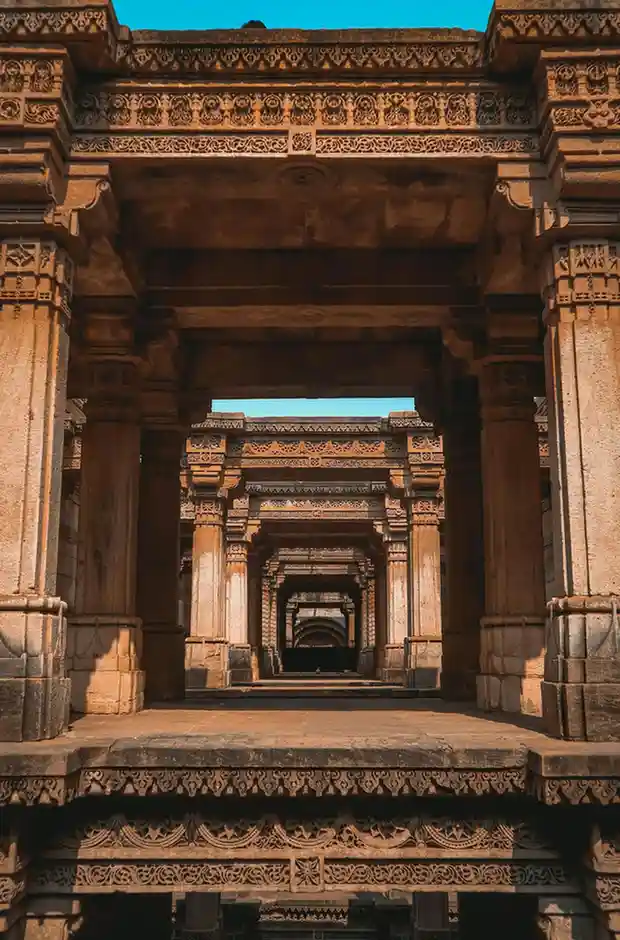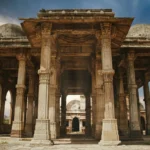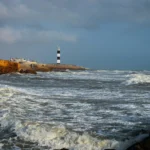Rani Ki Vav Patan – The Timeless Stepwell of Gujarat
In the heart of Patan, an ancient city in North Gujarat, stands one of India’s most architecturally stunning and historically significant stepwells — Rani Ki Vav. This UNESCO World Heritage Site is not only an engineering marvel but also a spiritual and cultural symbol of Gujarat. Built in the 11th century, Rani Ki Vav Patan is among the most intricate stepwells ever constructed and remains one of the top tourist places in Gujarat.
At Antriksh Travel, we bring you closer to the heritage of Gujarat through expertly curated tours to Patan Rani Ki Vav, ensuring you experience the glory of this ancient monument up close.
The Story Behind Rani Ki Vav – A Queen’s Tribute
Rani Ki Vav, or “The Queen’s Stepwell,” was commissioned by Queen Udayamati in memory of her husband King Bhimdev I, a ruler of the Solanki dynasty. The construction dates back to the 11th century and reflects the architectural brilliance of the Maru-Gurjara style prevalent during that period.
This magnificent stepwell in Gujarat was built not just as a water source but as a temple that goes down into the earth, symbolizing the sanctity of water in Hindu tradition. The name “Rani Ki Vav” pays tribute to the queen’s devotion, love, and artistic vision.
Architectural Excellence – Stepwell Design and Structure
The architecture of Rani Ki Vav Patan is a true masterpiece. It descends to a depth of around 27 meters with seven levels of stairs and platforms, each adorned with sculptures, carvings, and motifs. As you walk deeper into the stepwell, the beauty unfolds like a temple turned upside down.
There are over 500 principal sculptures and more than 1000 minor ones, depicting gods, goddesses, apsaras, sages, and mythological scenes from epics like the Ramayana and Mahabharata. The majority of the sculptures are dedicated to Lord Vishnu, showcased in his various forms like Kalki, Rama, Varaha, and Narasimha.
The detailing in the carvings — from jewelry designs to the expressions on the deities’ faces — makes Rani Ki Vav a rare example of ancient Indian stone craftsmanship.
Why Rani Ki Vav is a UNESCO Heritage Site
In 2014, Rani Ki Vav was declared a UNESCO World Heritage Site, recognizing it as “an exceptional example of a distinctive form of subterranean water architecture.” It stands as one of the finest and oldest examples of stepwells in India, serving both utilitarian and spiritual functions.
Its combination of engineering ingenuity, aesthetic richness, and religious symbolism makes it a marvel in Indian architecture. UNESCO has especially noted the harmonious integration of art and utility, which gives the site universal value.
Things to See in Rani Ki Vav Patan
When visiting Rani Ki Vav, several elements capture the attention of travelers and historians alike:
1. Sculptures of Deities
Each level of the stepwell is lined with intricately carved sculptures — particularly of Lord Vishnu in different avatars. These include Varaha (boar), Vamana (dwarf), Narasimha (lion-man), and Rama, presenting a vivid narrative from Vaishnav mythology.
2. Apsaras and Dancers
Elegant sculptures of apsaras (celestial dancers) adorn the walls. Their postures, ornaments, and expressions highlight the finesse of Solanki artisanship.
3. The Inverted Temple Layout
One of the most unique aspects is the inverted temple architecture — the sanctum is at the lowest point, which contrasts traditional temples that rise above ground. This architectural design represents the sacred descent into water and spiritual depth.
4. Geometric Patterns
Beyond deities, you’ll find stunning floral patterns, lotus motifs, and geometric designs, demonstrating the blend of mathematics and art in Indian architecture.
Best Time to Visit Rani Ki Vav
The ideal time to explore Rani Ki Vav Patan is between October and March, when the weather is cool and ideal for walking tours. During this season, visibility is also perfect for photographers to capture the intricate details of the sculptures.
If you’re visiting during December, don’t miss the Rani Ki Vav Festival, organized by Gujarat Tourism. This cultural event showcases local art, music, food, and heritage through live performances and exhibitions.
How to Reach Rani Ki Vav, Patan
By Road: Patan is well-connected by roads. It’s around 125 km from Ahmedabad and 50 km from Mehsana. Taxis and buses are easily available.
By Train: The nearest railway station is Patan Railway Station, connected to Mehsana and Ahmedabad.
By Air: The closest airport is Sardar Vallabhbhai Patel International Airport in Ahmedabad.
Antriksh Travel offers customizable Patan tour packages that include pickup, guided tours of Rani Ki Vav, and optional extensions to Modhera, Siddhpur, or Little Rann of Kutch.
Tips for Travelers
Footwear is not allowed inside the stepwell, so wear easy-to-remove shoes.
Carry a camera, as the light and shadows at different times of day add magical depth to your photographs.
Visit early in the morning or late afternoon for the best lighting and fewer crowds.
Consider hiring a heritage guide to understand the deeper symbolism in the artwork and mythology.
Nearby Attractions in Patan
After visiting Rani Ki Vav, explore these nearby Patan tourist places:
Patola House Museum – Learn about the double ikat Patola sarees, a dying art form preserved by generations.
Sahastralinga Talav – An ancient water tank filled with shivlings.
Panchasara Jain Temple – A peaceful Jain temple known for its marble carvings.
Hemachandracharya Jain Gyan Mandir – A historic library with rare Jain manuscripts.
Combining these with Rani Ki Vav makes for a complete heritage experience in Patan Gujarat.
Book with Antriksh Travel – Your Gateway to Gujarat Heritage
At Antriksh Travel, we provide immersive, culture-rich experiences through our Patan heritage tours. Our guides ensure that every sculpture at Rani Ki Vav comes alive with stories, while our personalized itineraries ensure a comfortable and enriching journey.
Whether you’re a photographer, history buff, or first-time traveler in Gujarat, visiting Rani Ki Vav Patan will leave you in awe of India’s artistic and spiritual legacy.




